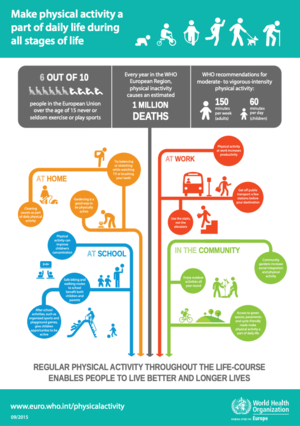what is Physical Activity?
Physical Activity (PA) is defined as any bodily movement produced by contraction of skeletal muscles that require energy expenditure.

Definitions
Physical Activity
Any time your body moves because of skeletal muscle contraction and oxygen consumption, you are engaging in physical activity (PA)[1]. Playing, working, using active transportation, doing housework, and recreational activities are all examples of physical activity.
Exercise
To enhance or maintain one or more aspects of physical fitness, exercise is a type of physical activity that is deliberate in its design, duration, intensity, and frequency.
Physical Inactivity
The term "physical inactivity" (PI) refers to the lack of or insufficient participation in physical exercise across a variety of settings, including the workplace, the home, public transportation, and free leisure.

Sedentary behaviour
Any kind of walking where the energy expended is less than 1.5 metabolic equivalents when the person is seated or lying down is considered sedentary behavior. In a broad sense, this defines sedentary behavior as occurring whenever a person is not actively moving. Among the most common sedentary activities include watching television, playing video games, and using computers ("screen time"), riding in cars, and reading[4]. Being physically inactive is different from engaging in sedentary behavior. Independent of whether or not a person gets the necessary amount of exercise, it is still a predictor of metabolic risk.[5]
Physical Activity as a Public Health Priority
It is well-established that engaging in regular physical activity has positive effects on health, including lowering the risk of dying from chronic diseases.[6][7] The global health consequences of inactivity are substantial[8]. The percentage of physically inactive people aged 15 and up is 31%.[9] Increased physical activity among the world's population could prevent four to five million deaths annually[10][1]. Low- and middle-income countries (LMICs) account for 2.6 million of the global 5.4 million fatalities related to inactivity. Although sedentary lifestyles are more common in high- and middle-income nations, research shows they are among the top ten risk factors for death everywhere.
Key facts on physical activity from The World Health Organisation
Working out benefits the cardiovascular system, muscles, and brain.
Heart disease, type 2 diabetes, and cancer account for roughly three-quarters of all fatalities worldwide, but can be prevented and/or managed with regular physical activity. As an added bonus, regular exercise has been shown to improve mood, cognition, and well-being.
Second, any form of physical activity is preferable to none at all.
The World Health Organization (WHO) recommends that everyone, regardless of age, engage in 150–300 minutes of moderate aerobic activity per week (or the equivalent in strenuous activity) and that children and adolescents engage in an average of 60 minutes of moderate aerobic physical activity every day.
Third, any form of exercise is beneficial.
Work, play, and travel (on foot, by bike, or in a car) all count as physical activity, as do chores around the house and yard.
Everyone can gain from working out their muscles.
To reduce the risk of falling and enhance overall health, persons 65 and up should engage in more activities that focus on balance and coordination, as well as muscular strengthening.
5. Being too inactive can have negative health effects.
There is some evidence that it also raises the odds of developing cancer and type 2 diabetes. Reduce your time spent sitting and increase your activity level for better health.
Increased physical activity and decreased inactive time are beneficial for everyone, but especially for pregnant and postpartum women and those with chronic health issues or disabilities.
Benefits of Physical Activity
Physical activity has far-reaching benefits, including roles in both disease prevention and chronic disease management. The British Heart Foundation[11] has released a report summarizing the evidence on exercise's ability to:
Reduce the number of untimely deaths and the prevalence of disease by focusing on prevention.
Improve emotional and psychological health as well as self-assessed wellness.
Care for older persons (those 65 and up) can be put off.
Find ways to lessen health disparities and enhance broader determinants of health and happiness.
Many serious NCDs can be avoided with regular exercise. Children and teenagers who engage in regular physical activity are more likely to grow into healthy adults. Physical inactivity contributes to the increase of NCDs, which now account for more deaths worldwide than all other causes combined, along with other prevalent risk factors such as hypertension, tobacco use, and bad nutrition. Getting some exercise also helps with focus, confidence, and academic success.
Global Strategy
The World Health Organization (WHO) adopted the "Global Strategy on Diet, Physical Activity, and Health" in May 2004 in response to the unprecedented chance to significantly reduce global mortality and disease burden through dietary and physical activity interventions.
There are four overarching goals of the global strategy.
Public health measures should be taken to reduce the prevalence of risk factors for chronic diseases caused by poor nutrition and lack of exercise.
Raise people's consciousness about the benefits of preventing illness by changes in lifestyle (such as food and exercise).
Sustainable, all-encompassing programs that actively include all sectors must be developed, strengthened, and implemented on a global, regional, and national scale to improve diets and boost physical activity.
Keep an eye on the evidence and push for studies on nutrition and exercise.
The World Health Organization (WHO) has been diligently working to enhance global population health since this paper was published in 2004. After the World Health Organization (WHO) established that noncommunicable diseases (NCDs) cause a disproportionate number of early deaths, all countries pledged in 2012 to reduce NCD-related premature mortality by 25% by 2025 (the 25x25 target).Countdown to 25 by 25: NCD Alliance.

Countries have projected that reducing the six risk factors for having an NCD will help them reach their goal of reducing early deaths from NCDs. Here are the six possible dangers:
Drug and alcohol abuse
Intake of Salt
Obesity Hypertension
Blood sugar levels
The Lancet published an article discussing the six risk factors.
The World Health Organization (WHO) published its Global Health Status Report in 2014[13], which contained 9 Global objectives to continue trying to address the NCD epidemic, one of which was the 25x25 target. Other foci include:
Overall mortality from cardiovascular disease, cancer, diabetes, and chronic respiratory illness decreased by 25% relative to baseline.
10% or more reduction in alcohol-related harm, as applicable to the national context
The rate of inactivity due to lack of exercise dropped by 10%
The average amount of salt and sodium consumed by the population decreased by 30 percent.
The current smoking rate has decreased by 30% compared to the previous year.
25% relative reduction in the prevalence of high blood pressure or, depending on national circumstances, contain the prevalence of high blood pressure
Stop the alarming increase of diabetes and obesity.
Half or more of those who are eligible receive anti-arrhythmic medication therapy and counseling (including glycemic management)
At least 80% of the public and commercial healthcare institutions have access to the low-cost basic technology and key medicines, including generics, needed to treat major noncommunicable illnesses.
The World Health Organization (WHO) released its Global Action Plan to Promote Physical Activity (GAPPA) in 2018. To boost physical activity at all ages and levels, countries have asked for new guidelines, and this plan provides it. To achieve a paradigm change in both supporting and rewarding all people being routinely active, according to ability and across the life course, this strategy answers to calls for global leadership and increased regional and national cooperation as well as a response from the entirety of society. Governments and key stakeholders from the health, sports, transportation, urban planning, civil society, academic, and business sectors were consulted globally to produce the action plan.
Physical Activity Guidelines (PAGs)
The World Health Organization's (WHO) "Global Recommendations on Physical Activity for Health"[14] were created with the overarching goal of providing national and regional level policy-makers with guidance on the dose-response relationship between the frequency, duration, intensity, type, and total amount of physical activity necessary for the prevention of NCDs.
According to WHO Europe, staying physically active is one of the best ways to improve health and extend life span. For nations, communities, individuals, and especially patients with long term health concerns, this infographic summarizes the opportunities of a "life course approach" to make physical exercise part of everyday life.

Physiotherapy and Physical Activity
The field of physiotherapy has deep roots in the prescription of rehabilitative exercise because it was formed on the work of remedial gymnastics. Despite this, research on physiotherapists' efficacy as advocates for exercise is limited.
There is an immediate need to build on our long tradition of prescription exercise and advance our strategies for prescribing PA in response to the worldwide epidemic of lifestyle-related disorders (NCDs). Physiotherapists should be proactive in interacting with individuals and communities in order to foster the kind of joined-up thinking and activity that will lead to a more physically active population.
Physiotherapists have a lot to offer patients, including access to those who are living with chronic diseases, repeat consultations, exercise facilities, credibility with patients, specialized knowledge, and the ability to change patient behavior in response to injury or illness.
In the United Kingdom, primary care physicians and other medical staff are able to provide patients with physical activity brief treatments as part of a larger system of personalized care and population health. Every healthcare organization in the UK must also encourage medical staff to "make every contact count" (MECC) when it comes to encouraging patients to get more exercise. These guidelines give physiotherapists (and other health and social care workers) the authority to help the World Health Organization achieve its goal of reducing physical inactivity by 10% worldwide by 2025.













